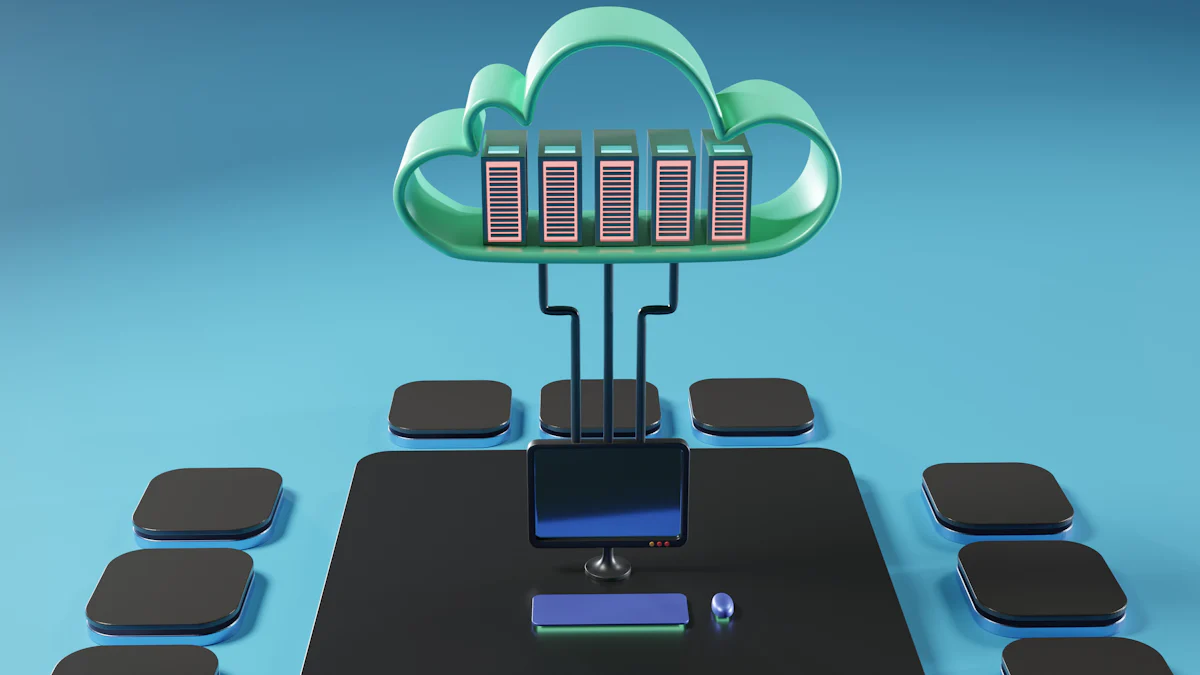Feature Toggles AWS: A Smarter Way to Develop

Feature toggles in AWS give you the power to control software features dynamically. They allow you to deploy new features faster while reducing risks. For example, you can release a feature to just 1% of users, monitor its performance, and gradually expand access. If something goes wrong, you can instantly turn it off. This approach ensures smooth deployments without compromising speed. Feature toggles also improve collaboration. Teams can work on separate features in the same repository without disrupting each other. By using feature toggle AWS solutions, you can streamline development and deliver better results.
Key Takeaways
Feature toggles let you turn software features on or off easily. This helps with faster updates and fewer problems.
Test new features in real environments without showing them to everyone. This makes launching updates smoother.
Use feature toggles to release updates carefully and avoid big issues. You can quickly turn off features if needed.
Help your team work better by letting developers build different features at the same time without causing conflicts.
Use AWS tools like AppConfig to manage feature toggles well. This allows quick changes and better user experiences.
Understanding Feature Toggles
What Are Feature Toggles?
Feature toggles are tools that allow you to control the activation of specific software features without redeploying your application. Think of them as light switches for your code. You can turn features on or off dynamically, even in a live environment. This flexibility aligns with modern practices like agile development and DevOps.
Feature toggles let you merge incomplete features into the main codebase while keeping them hidden from users. This approach supports continuous integration and deployment. You can also test new functionalities directly in production, conduct A/B testing, or roll out features gradually. If something goes wrong, you can instantly disable the feature, ensuring minimal disruption.
Types of Feature Toggles
Feature toggles come in various types, each serving a unique purpose. Here are the most common ones:
Type of Feature Toggle | Description | Use Cases |
|---|---|---|
Release Toggles | Allow incomplete and untested codepaths to be shipped to production as latent code. | Used for trunk-based development and to prevent exposing half-complete features to users. |
Experiment Toggles | Used for multivariate or A/B testing by placing users into cohorts. | Helps in making data-driven optimizations in systems like ecommerce. |
Ops Toggles | Control operational aspects of system behavior. | Allows quick disabling or degrading of features with unclear performance implications. |
Permission Toggles | Manage feature visibility based on user roles or permissions. | Useful for enabling features for specific user groups. |
Each type of toggle plays a critical role in managing your application’s behavior and user experience.
Why Feature Toggles Are Essential in Software Development
Feature toggles are vital for modern software development. They provide flexibility in managing features and support continuous integration and deployment. With feature toggles, you can test in production, conduct A/B testing, and perform quick rollbacks without redeploying your application. This capability reduces risks and ensures smoother deployments.
Feature toggles also enhance collaboration among teams. Developers can work on different features simultaneously without interfering with each other’s progress. Additionally, they help manage complexity by isolating features, making it easier to debug and troubleshoot issues. Tools like aws appconfig make implementing feature toggles in AWS environments even more efficient, enabling you to deliver high-quality software faster.
Benefits of Feature Toggles in AWS

Accelerating Deployment Cycles
Feature toggles in AWS help you push out new features faster by allowing gradual exposure to users. This approach lets you gather feedback and refine implementations before a full rollout. You can test new features in a live environment without exposing them to all users, which minimizes deployment risk. By selectively enabling or disabling features, you can ensure that only stable functionalities reach your audience.
Using AWS tools like aws appconfig, you can manage feature toggles efficiently. This centralized feature toggle management system provides real-time control over the current state of all feature toggles. It enables you to deploy updates without waiting for complete development, speeding up your deployment cycles. This software development technique ensures that your team can deliver value to users more quickly.
Reducing Risks with Controlled Rollouts
Controlled rollouts are a powerful way to minimize deployment risk. Feature toggles allow you to hide new features until they are ready for broader use. With AWS, you can implement a "Dark Launch" strategy, where features are tested on a small user base first. This method helps you monitor performance and identify potential issues early.
AWS appconfig makes it easy to execute granular rollouts. You can gradually expose features to specific user groups, reducing the chance of widespread disruptions. If a problem arises, you can instantly disable the feature without redeploying the application. This flexibility ensures safer deployments and quicker recovery from unexpected issues.
Enhancing Team Collaboration
Feature toggles reduce cross-team dependencies, enabling developers to work on separate features simultaneously. Teams can merge incomplete features into the main codebase without affecting the live environment. This approach fosters collaboration and streamlines the development process.
AWS appconfig supports real-time feature toggles, allowing teams to adjust features dynamically. By managing feature toggles centrally, you can ensure that all teams have visibility into the current state of all feature toggles. This transparency improves coordination and helps teams deliver high-quality software efficiently.
Improving User Experience Through Real-Time Adjustments
Feature toggles in AWS give you the ability to fine-tune user experiences instantly. By using tools like aws appconfig, you can adjust features in real time without redeploying your application. This flexibility allows you to respond quickly to user feedback or unexpected issues, ensuring a seamless experience for your audience.
Imagine you’ve launched a new feature, but users report confusion or difficulty. With feature toggles, you can modify or disable the feature immediately. This approach minimizes frustration and keeps your application running smoothly. You can also use aws appconfig to test different versions of a feature with specific user groups. This strategy helps you identify what works best, improving satisfaction and engagement.
Real-time adjustments also support personalization. You can use feature toggles to deliver tailored experiences based on user preferences or behavior. For example, an e-commerce platform can show different promotions to different customer segments. AWS tools make it easy to manage these dynamic changes, ensuring that each user gets the most relevant experience.
Another advantage is the ability to address performance issues on the fly. If a feature causes slowdowns, you can disable it instantly while investigating the problem. AWS appconfig provides centralized control, making these adjustments straightforward and efficient. This capability not only enhances user experience but also protects your brand reputation.
By leveraging feature toggles in AWS, you can create a more responsive and user-focused application. Real-time adjustments ensure that your software evolves with your users’ needs, delivering value at every step.
Practical Applications of Feature Toggles in AWS
A/B Testing and Feature Validation
Feature toggles play a crucial role in A/B testing and validating new features. With AWS AppConfig, you can introduce features to specific user groups and compare their performance. This approach allows you to test different versions of a feature simultaneously. For example, you can show one group a new design while another group sees the original version. By analyzing user behavior, you can determine which version performs better.
Feature toggles also help you control access to features. You can selectively enable or disable features for specific users, ensuring that only the intended audience interacts with them. AWS AppConfig integrates with Amazon CloudWatch, providing real-time monitoring of feature flag changes. This integration enhances operational control and ensures that you can track the impact of your experiments effectively. If a feature causes issues, you can quickly disable it without affecting the entire application.
Phased Rollouts for New Features
Phased rollouts allow you to deploy new features gradually, reducing risks and ensuring a smoother user experience. Feature toggles enable you to release features to a small group of users first. This controlled testing helps you identify and fix potential issues before a full rollout. With AWS, you can manage the timeline and conditions for feature activation, ensuring a seamless deployment process.
AWS AppConfig simplifies incremental releases by allowing you to enable or disable features without deploying new software versions. This flexibility minimizes the risk of bugs and ensures that your application remains stable. By using feature toggles, you can test new functionalities in a live environment without exposing them to all users. This approach not only enhances user satisfaction but also supports continuous delivery.
Debugging and Troubleshooting in Production
Feature toggles are invaluable for debugging and troubleshooting in production environments. They allow you to test new features in real-time without exposing them to all users. If a feature fails, you can quickly roll it back by toggling it off. This capability eliminates the need to modify the source code, saving time and reducing risks.
AWS AppConfig provides centralized control over the current state of all feature toggles. This real-time feature toggles management ensures that you can address issues promptly. For example, if a feature causes performance problems, you can disable it instantly while investigating the root cause. This approach minimizes disruptions and protects your application’s stability. By selectively enabling or disabling features, you can maintain a high-quality user experience even during troubleshooting.
Dynamic Feature Management for Continuous Delivery
Dynamic feature management plays a crucial role in achieving continuous delivery. With feature toggles, you can control the activation of features without redeploying your application. This flexibility allows you to release updates faster and with greater confidence. AWS provides powerful tools like aws appconfig to help you manage feature toggles effectively.
You can use feature toggles to maintain the current state of all feature toggles in your application. This centralized control ensures that you can enable or disable features instantly. For example, if a new feature causes issues, you can turn it off immediately. This approach minimizes downtime and protects the user experience.
Real-time feature toggles allow you to adjust features dynamically. You can respond to user feedback or performance issues without waiting for a new deployment. AWS appconfig makes this process seamless by providing a user-friendly interface for managing feature toggles. You can also monitor the impact of changes in real time, ensuring that your application remains stable.
Feature toggles also support continuous delivery by enabling incremental rollouts. You can release features to small user groups first, gather feedback, and make improvements before a full launch. This strategy reduces risks and ensures that your updates meet user expectations. AWS appconfig simplifies this process by allowing you to define rollout conditions and timelines.
Dynamic feature management enhances your ability to deliver high-quality software. By leveraging AWS tools, you can streamline your development process and improve operational efficiency. Feature toggles empower you to innovate faster while maintaining control over your application’s behavior.
Implementing Feature Toggles in AWS

AWS Tools and Services for Feature Toggles
AWS provides several tools to help you implement feature toggles effectively. These tools simplify the process and ensure seamless integration into your applications:
AWS AppConfig allows you to store and manage feature toggles in formats like JSON or YAML. It works well with AWS Lambda and containerized applications, making it versatile for various environments.
AWS CloudWatch Evidently enables gradual feature rollouts. You can monitor user feedback and performance metrics during these rollouts, ensuring smooth transitions.
AWS Lambda supports both static and dynamic feature toggles. You can use it alongside AWS AppConfig to manage toggles efficiently.
These tools empower you to control feature toggles dynamically, ensuring flexibility and reliability in your deployments.
Best Practices for Managing Feature Flags
Managing feature flags effectively is crucial for maintaining a clean and efficient codebase. Follow these best practices to avoid common pitfalls:
Keep feature flags short-lived. Use them for temporary purposes like A/B testing or phased rollouts. Remove them once they are no longer needed to reduce complexity.
Use a dedicated flag management tool. While AWS AppConfig is excellent, tools like LaunchDarkly offer advanced features for larger-scale projects.
Monitor feature flags closely. Set up alerts to detect errors or performance issues caused by toggles. This proactive approach helps you disable problematic flags quickly.
By adhering to these practices, you can ensure that feature flags enhance your development process without introducing unnecessary technical debt.
Monitoring and Observability for Feature Toggles
Monitoring feature toggles is essential for understanding their impact on your application. AWS offers robust tools to help you track and analyze toggle performance:
Amazon CloudWatch collects metrics and logs, providing visibility into resource utilization and application performance. You can set alarms to detect changes in toggle behavior.
AWS CloudWatch Evidently supports gradual feature rollouts. It monitors user feedback and performance, helping you identify potential issues early.
These tools allow you to observe how feature toggles affect your application in real time. By leveraging them, you can ensure that your toggles deliver the desired outcomes while maintaining application stability.
Avoiding Common Pitfalls in Feature Toggle Implementation
Feature toggles are powerful tools, but improper implementation can lead to challenges. By understanding common pitfalls, you can avoid unnecessary complications and maximize their benefits.
Leaving Feature Toggles Active for Too Long
Temporary feature toggles often become permanent if not managed properly. This can clutter your codebase and increase technical debt. Always set a clear expiration date for each toggle. Use tools like aws appconfig to track and remove unused toggles.Overcomplicating Toggle Logic
Complex toggle conditions make your application harder to maintain. Keep toggle logic simple and easy to understand. For example, avoid nesting multiple toggles within a single feature. Instead, use aws appconfig to centralize and simplify toggle management.Failing to Monitor Toggle Performance
Without proper monitoring, you might miss issues caused by toggles. Use AWS tools like CloudWatch to track the impact of feature toggles on performance. Monitoring ensures you can quickly identify and resolve problems.Not Documenting Toggles
Lack of documentation creates confusion among team members. Always document the purpose, status, and expiration of each toggle. AWS appconfig allows you to store metadata for toggles, making it easier to keep everyone informed.
Tip: Regularly review your toggles to ensure they align with your development goals. Remove toggles that are no longer needed to maintain a clean codebase.
Ignoring Security Risks
Poorly implemented toggles can expose sensitive features to unauthorized users. Use permission-based toggles to control access. AWS provides robust tools to secure your toggles and protect your application.
By avoiding these pitfalls, you can use feature toggles effectively. AWS tools like aws appconfig simplify toggle management, helping you maintain a stable and efficient application.
Feature toggles have transformed modern software development. They let you test features with specific user groups, enabling data-driven decisions. You can roll back features instantly, ensuring stability and user satisfaction. Teams can work on separate features simultaneously, streamlining collaboration and release cycles. By decoupling deployment from releases, feature toggles support continuous integration and deployment.
AWS tools like CloudWatch Evidently enhance these benefits. They allow gradual feature rollouts, real-time adjustments, and live testing without full exposure. This approach reduces risks and fosters innovation. By following best practices, you can maximize the potential of feature toggles and deliver exceptional user experiences.
FAQ
What is the difference between feature toggles and traditional configuration settings?
Feature toggles control the activation of specific features dynamically, even in live environments. Traditional configuration settings, on the other hand, manage static application behaviors. Feature toggles allow you to test, roll out, or disable features without redeploying your application.
Can feature toggles impact application performance?
Yes, poorly implemented toggles can slow down your application. To avoid this, use lightweight toggle libraries and monitor performance with tools like Amazon CloudWatch. Regularly review and remove unused toggles to keep your codebase clean and efficient.
How do you secure feature toggles in AWS?
You can secure toggles by using permission-based access controls. AWS AppConfig allows you to define roles and restrict access to sensitive toggles. Always encrypt toggle data and monitor changes to prevent unauthorized modifications.
Are feature toggles suitable for all types of applications?
Feature toggles work best in applications with frequent updates or complex user interactions. They may not be necessary for static or rarely updated systems. Evaluate your application’s needs before implementing toggles.
How do you manage feature toggles in large teams?
Centralized tools like AWS AppConfig simplify toggle management. Use clear naming conventions and document each toggle’s purpose. Regularly communicate toggle changes with your team to ensure everyone stays informed and aligned.
Tip: Schedule periodic reviews to remove outdated toggles and reduce technical debt.
See Also
The Importance of Feature Toggles in .NET Development 2025
Top 12 Feature Toggle Solutions for Developers in 2025
Three Key Benefits of Feature Toggles for Spring Boot

